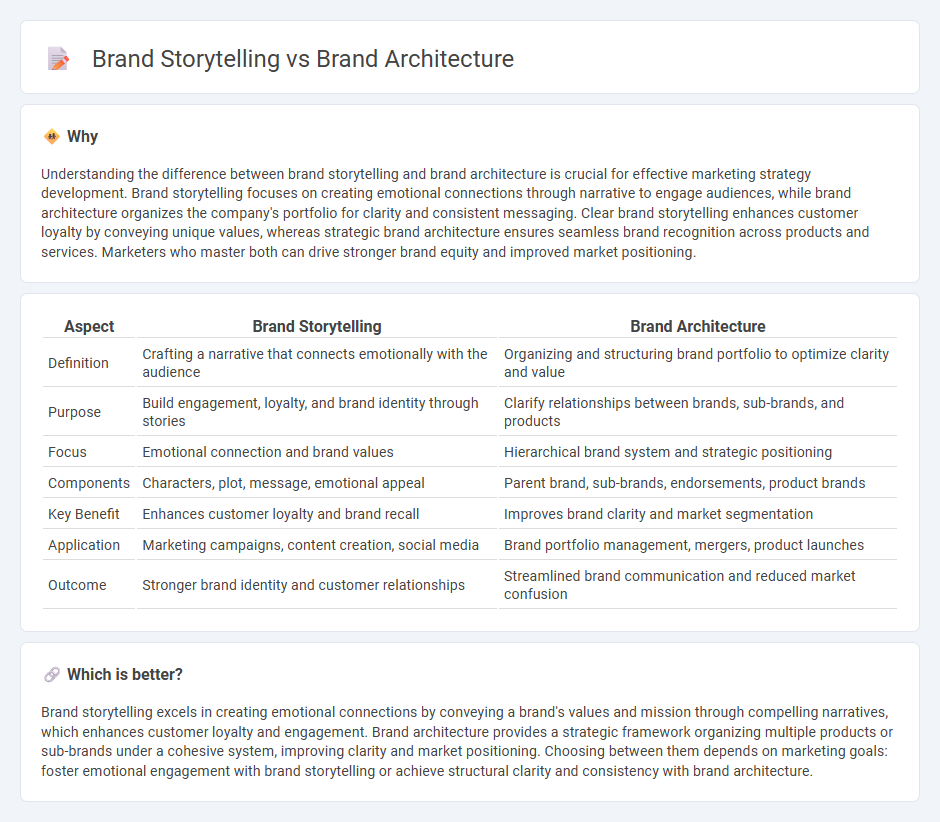
Brand storytelling focuses on creating a compelling narrative that connects emotionally with consumers, enhancing brand identity and loyalty. In contrast, brand architecture organizes and structures multiple brands or sub-brands within a company to ensure clarity and strategic alignment. Explore deeper insights to understand how combining these strategies can elevate your marketing success.
Why it is important
Understanding the difference between brand storytelling and brand architecture is crucial for effective marketing strategy development. Brand storytelling focuses on creating emotional connections through narrative to engage audiences, while brand architecture organizes the company's portfolio for clarity and consistent messaging. Clear brand storytelling enhances customer loyalty by conveying unique values, whereas strategic brand architecture ensures seamless brand recognition across products and services. Marketers who master both can drive stronger brand equity and improved market positioning.
Comparison Table
| Aspect | Brand Storytelling | Brand Architecture |
|---|---|---|
| Definition | Crafting a narrative that connects emotionally with the audience | Organizing and structuring brand portfolio to optimize clarity and value |
| Purpose | Build engagement, loyalty, and brand identity through stories | Clarify relationships between brands, sub-brands, and products |
| Focus | Emotional connection and brand values | Hierarchical brand system and strategic positioning |
| Components | Characters, plot, message, emotional appeal | Parent brand, sub-brands, endorsements, product brands |
| Key Benefit | Enhances customer loyalty and brand recall | Improves brand clarity and market segmentation |
| Application | Marketing campaigns, content creation, social media | Brand portfolio management, mergers, product launches |
| Outcome | Stronger brand identity and customer relationships | Streamlined brand communication and reduced market confusion |
Which is better?
Brand storytelling excels in creating emotional connections by conveying a brand's values and mission through compelling narratives, which enhances customer loyalty and engagement. Brand architecture provides a strategic framework organizing multiple products or sub-brands under a cohesive system, improving clarity and market positioning. Choosing between them depends on marketing goals: foster emotional engagement with brand storytelling or achieve structural clarity and consistency with brand architecture.
Connection
Brand storytelling enhances brand architecture by clearly communicating the core values, mission, and identity of each brand within a portfolio, creating a cohesive narrative that resonates with target audiences. Effective brand architecture organizes multiple brands or sub-brands strategically, guiding consistent storytelling that builds stronger emotional connections and reinforces brand equity. This synergy ensures clarity, differentiates offerings, and maximizes the impact of marketing efforts across various channels.
Key Terms
**Brand Architecture:**
Brand architecture defines the structure and organization of a company's portfolio, detailing relationships between the corporate brand, sub-brands, and product lines to ensure clarity and consistency across markets. It optimizes brand equity by strategically positioning each brand element to target different customer segments and maximize market reach. Discover how a well-planned brand architecture can strengthen your business identity and drive growth.
Brand Hierarchy
Brand architecture organizes a company's portfolio by defining relationships between parent brands and sub-brands, establishing a clear brand hierarchy that enhances market clarity and consumer understanding. This hierarchy strategically positions each brand's role, ensuring consistent messaging and maximizing brand equity across product lines. Discover how mastering brand hierarchy can strengthen your overall brand strategy.
Sub-brand
Sub-brand strategy involves creating a distinct identity that resonates within the larger brand architecture, balancing autonomy and alignment with the parent brand. Effective sub-brand storytelling enhances emotional connection by tailoring narratives that reflect unique values while supporting overall brand coherence. Explore how integrating sub-brand storytelling into brand architecture amplifies market impact and customer loyalty.
Source and External Links
Brand Architecture: Types & Best Examples - This article discusses the different types of brand architectures, focusing on the Branded House model where a single master brand dominates over sub-brands, highlighting examples like FedEx and Apple.
The Complete Guide to Brand Architecture - This guide explains the components of brand architecture, including the master brand and sub-brands, using Apple as an example of a master brand with multiple sub-brands.
Brand Architecture: What It Is, Models, and 3 Examples - This page provides an overview of brand architecture, discussing its role in organizing a company's brands and products, and offers guidance on creating a cohesive brand architecture strategy.
 dowidth.com
dowidth.com